INTRODUCTION: “Mathematics is not just about numbers, equations, computations or algorithms; it is about understanding” —-William Paul Thurston, an eminent mathematician.
For common people or as layman mathematics means it’s all about numbers. Mathematics is a science of numbers along with logical and arithmetical operations. Generally, in our curriculum we start mathematics as arithmetic. As we grow, we develop mental sense, psychological sense and logical sense of different geometrical figures, mathematical operations as addition, subtraction, multiplication and division and logical operations such as greater than less than etc. At the age of around 13-14 we start doing algebra with an unknown variable to find.
At an advanced level we become familiar with calculus and different software languages and the modern introduction of Artificial Intelligence (AI).
No subjects, not only science can go without mathematics. So that it is called “Mother of all Science”.
In our everyday life we make serious or silly mistakes. We do mistakes in the field of education. Some of us cannot remember the text in subjects like English, Hindi or basically language-based subjects and even in social studies we cannot end with perfect points. It affects our testing procedure and the examination but we don’t lose the full marks but in a subject like Mathematics it ends with a havoc loss.
So, I like to point out different types of mistakes committed by the students in their daily practices or in the examination centre either due to examination tension, psychological pressure, irregular practices, proper understanding of the subject, non-seriousness, lack of knowledge, misconceptions or short of time or sometimes lack of confidence and etc.
To learn these subjects we make some common mistakes which leads to reduce performance in terms of marks and conception and also knowledge.
Mainly there are two types of errors:
1. Careless error.
2. Conceptual error.
Careless error: Careless error generally occurs due in – attentive mind, peer pressure to finish work as fast as possible, writing wrong mathematical symbols, noting wrong numbers etc. This can be divided point wise also:
1. Conversion of statement into mathematical form.
2. Note down of wrong numbers from Questions.
3. Two mathematical symbols written consecutively without separation.
4. Sloppy handwriting.
5. Clicking wrong numbers in the calculator etc.
Conceptual Problem: These problems generally occur due to lack of knowledge or incomplete concept of the topics. So, the students end up with errors. These problems occur in case of multi-step word problem, multi-step simplification of fractions and in case of long division.
Examples of some common mistakes committed by the students in case of Addition, Subtraction, Multiplication, Division, Distribution of Brackets, Simplification etc
Laws of powers and indices:
Wrong: Correct:
Wrong: Correct:
3^(-2)=1/3^(-2) Correct: 3^(-2)=1/3^2
(Cause of this mistake is incomplete explanation of the teacher which goes like” if there is minus sign take it in the position of denominator”, we are not saying with change of sign).
In case of doing LCM of fractions:
Wrong: (3 )/2+4/(3 )=7/5 (Addition numerator and addition of denominator)
Correct: 3/2+(4 )/3=(3×3+4×2)/6=(9+8 )/6=17/6
For children we can teach one tips for addition or subtraction of fractions:
9/(8 )+ 2/3=(9 × 3+8 ×2)/(8 ×3) =(27+16)/24= 43/24
9/(8 )- 2/3=(9 × 3-8 ×2)/(8 ×3) =(27-16)/24= 11/24
Mistakes in doing Simplification:
Wrong: (5 + 3) (3 – 5) = 8 – 2= 6
Correct: (5 + 3) (3 – 5) = 8 ×(-2)=-16
(In case of multiplication minus sign to be separated by means of a bracket)
Wrong: (3x-2y)/(x+y )=(3x )/x-2y/(y )=3-2=1Correct: (3x-2y)/(x+y )=(3x )/(x+y )-2y/(x+y) (This may be treated as a conceptual errors)
Wrong: (6 )/21÷3/7=(6/3)/(21/7)= 2/3
Correct way: (6 )/21÷3/7=6/21 × 7/3= 42/63=2/3
(In case division of two fractions, we have to take the reciprocal of the second fraction changing the ÷to× (Changing division sign to multiplication sign)
Misconception about the distribution of brackets such as:
Wrong: 5 (3 x + 5) + (x + 2) = 15x + 25 + 5x + 10 = 20 x + 35.
The correct way of doing:
5 (3 x + 5) + (x + 2) = 15x + 25 + x + 2 = 16 x + 27
Addition and subtraction of like terms:
Wrong: x + x + x + x = x 4
Correct: x + x + x + x = 4 x
(Cause of doing such mistakes: Psychological and thinking process go in the mind of students that x has been repeated 4 times, so, it would be x4)
The common mistake in combining like terms: 7 (3x + 4 y) =7×7xy=49 xy.
The correct way of doing this simplification is: 7 (3 x + 4 y) = 21 x+28 y
This is happened due to improper knowledge of addition or subtraction of like terms.
Common mistake in cancellation of terms in a fraction:
Wrong: (3x-4y )/3z=(x-4y)/z .
Correct way: (3x-4y )/3z=(3x-4y)/3z
This is the mistake done by the immediate action of active mind and the students immediately cancel out the coefficient of one term only.
Wrong: (3 )/7+ 4/5=(3+4)/(7+5 )=7/12Correct: (3 )/7+ 4/5=(3 ×5+4×7)/(7×5 )=(15+28)/35= 43/35
Cause of these types of mistakes is a conceptual one. Students are doing addition of numerators and addition of denominators.
Order of operations:
Wrong: Correct: 60 + 3×6=60+18=78
60 + 3 ×6
= 63 ×6=378
Screen shots of some mistakes has been given below:
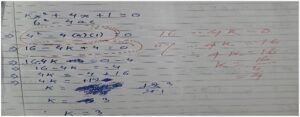
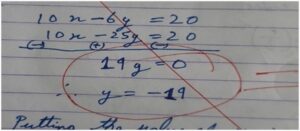
Conceptual mistake

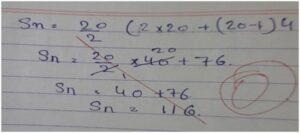
Immediate action of mind (cancellation of x) lost the sense of using Bracket
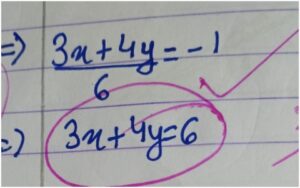
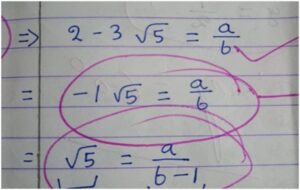
Lack of knowledge of like & unlike terms Conceptual Mistake

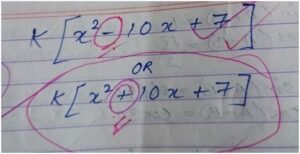 A revision can remove such mistake Lack of sense of expression & Equation
A revision can remove such mistake Lack of sense of expression & Equation
Action of Active mind/Conceptual mistake
CONCLUSION: We know nothing just after birth but as we are growing day by day we learn new skills, develop new techniques and methodology to face the challenges in life and we make mistakes. We don’t know the answers or goals of our life before we begin. The same things happen in the case of learning mathematics or beginning with mathematics.
Learning Mathematics requires a lot of practice and making mistakes is a part of success in life and helps kids to learn more and understand more deeply. Every human mind is a vast island of knowledge, may be in the conscious or unconscious state but its usage depends upon the individual’s attitude, social environment, social pattern, self beliefs, feelings, behaviours etc.
From my experience of teaching mathematics for the last 34 years under the CBSE curriculum I have found that the text books specially Mathematics, Physics, Chemistry etc published by the NCERT is a vast storage of information, knowledge and the books are defined technically so that students can easily understand the topics described there. The notes given in the Blue boxes in the NCERT mathematics book are the treasure island of knowledge, application, conception and learning methodology. Every topic is explained in such a way that a student will never think of hiring any other outsource to grasp it. I personally think regular attendance in school and continuous study at home will help them more, than the present day practices of Dummy classes in the different coaching centres.
I have tried to explain the common mistakes done by a student by depicting some snap shots above. These do not only happen due to lack of knowledge but sometimes are the cause of instant action of mind, peer pressure, forgetfulness, proper time management, proper revisions etc.
“A MAN MUST BE BIG ENOUGH TO ADMIT HIS MISTAKES, SMART ENOUGH TO PROFIT FROM THEM, AND STRONG ENOUGH TO CORRECT THEM”
—- By John C. Maxwell, an American author and a renowned speaker.
(By Mongal Saha, M.Sc (Maths), M.Sc (DISATER MITIGATION) B-Ed
Forner Vice Principal Army Public School, Narangi,
National Teachers Awarder-2009
EMAIL ID: [email protected])










